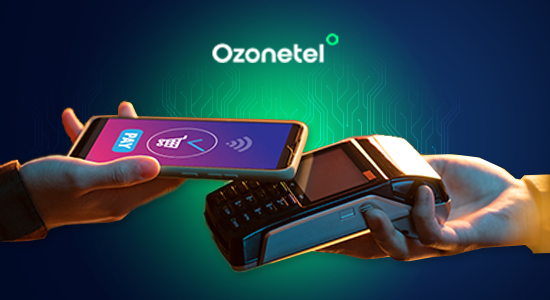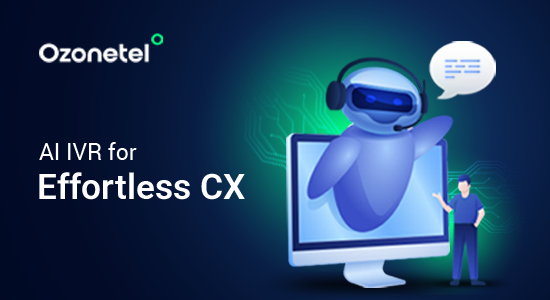- Resources
- Everything You Need to Know About Contact Center Software
Everything You Need to Know About Contact Center Software

Every customer conversation is a chance to build trust or lose it. When someone calls with a query, reaches out on chat, or sends a late-night email, what they want isn’t just a quick fix. They want to feel heard, understood, and valued. That’s where contact center software helps. It isn’t about replacing people with tools. It’s about giving teams the support they need to respond with speed, empathy, and context.
Contact center software is a centralized platform that lets your support, sales, and service teams manage all customer interactions in one place. With the right tools—like smart routing, real-time analytics, and AI-powered assistance—you can respond faster, resolve issues smarter, and create experiences customers remember.
In this guide, you’ll learn how businesses use contact center tools to reduce churn, improve efficiency, and deliver the kind of service customers remember (for the right reasons). Keep reading!
In this article, we will explore:
- 1. What is Contact Center Software?
- 2. Call Center Software Vs. Contact Center Software
- 3. Why You Should Implement Contact Center Software
- 4. Types of Contact Center Software
- 5. What Features Modern Contact Center Provide
- 6. How does AI in the Contact Center Help?
- 7. Use Cases of Contact Center Software
- 8. Why Ozonetel is a Smart Choice for Contact Center Transformation
What is Contact Center Software?
Contact center software is a set of tools designed to manage and improve customer interactions across multiple channels like phone, email, chat, and social media. It helps businesses streamline customer service operations by automating routine tasks, providing agents with necessary customer data and ensuring quick, personalized responses to inquiries.
By centralizing all customer interactions on one platform, contact center software improves agent efficiency, enhances the customer experience, and ensures timely resolution of issues—ultimately boosting satisfaction and loyalty.
Call Center Software Vs. Contact Center Software
Businesses often rely on specialized software solutions tailored to their needs when managing customer interactions. Call center software and contact center software are two such solutions that facilitate communication between customers and agents, but they serve different purposes and offer distinct features.
Here is a comparison table outlining the differences between call center software and contact center software:
| Feature | Call Center Software | Contact Center Software |
|---|---|---|
| Communication Channels | Primarily focused on voice calls. | Supports multiple communication channels such as voice calls, emails, chats, and social media. |
| Integration Capabilities | Limited integration with other systems. | Offers robust integration with CRM systems, help desk software, and other business applications. |
| Agent Collaboration | Basic features for agent collaboration. | Advanced tools for collaboration, including internal chat, file sharing, and presence management. |
| Omnichannel Support | Typically lacks omnichannel support. | Provides seamless omnichannel communication, allowing customers to switch between channels without losing context. |
| Customer Experience | Provides basic customer support functionalities. | Focuses on delivering enhanced customer experiences through personalized interactions and proactive engagement. |
| Analytics and Reporting | Basic reporting features. | Advanced analytics capabilities, offering insights into customer behavior, agent performance, and operational efficiency. |
Why You Should Implement Contact Center Software
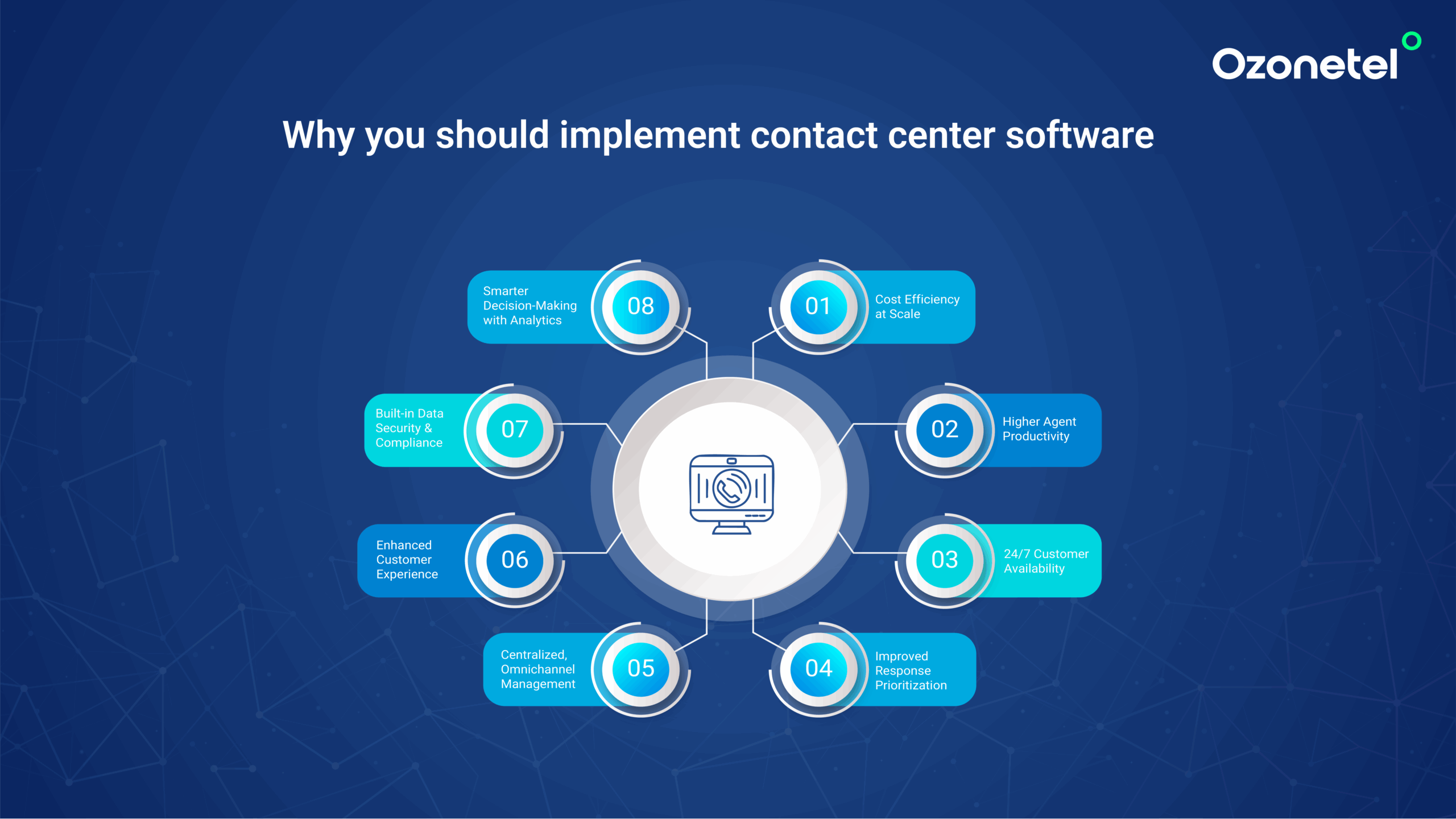
Whether you’re in retail, healthcare, fintech, or SaaS, modern contact center software helps you scale customer interactions, improve efficiency, and deliver standout service without adding unnecessary overhead. Here are the key benefits:
Cost Efficiency at Scale
Contact center software reduces dependency on large human support teams by automating high-volume interactions through . This helps businesses manage spikes in demand without compromising service quality—cutting costs without sacrificing performance.
Higher Agent Productivity
By automating repetitive tasks like call logging, ticket assignment, or answering FAQs, the software frees agents to focus on complex issues that require human judgment. This results in faster resolution, less burnout, and better use of agent time.
24/7 Customer Availability
AI-powered voicebots and chatbots allow customers to get help any time—nights, weekends, or holidays. This continuous availability increases customer satisfaction, builds trust, and reduces pressure on your human team to cover all time zones.
Improved Response Prioritization
Contact center software can identify and route urgent inquiries—like payment issues or outages—based on keywords, customer value, or sentiment analysis. This ensures high-priority issues are addressed first, reducing churn and improving customer loyalty.
Centralized, Omnichannel Management
Manage voice calls, emails, chats, and social media from a single dashboard. This unifies your customer communication and avoids context-switching, ensuring a smoother experience for both agents and customers.
Enhanced Customer Experience
With features like real-time analytics, CRM integration, and historical interaction tracking, agents have full context before they engage. This allows for faster, more personalized support—and fewer repeated questions for your customers.
Built-in Data Security & Compliance
Top-tier contact center platforms come with robust data encryption, access control, and cloud backups. This reduces the need for additional infrastructure while ensuring your operations stay compliant with regulations like GDPR, HIPAA, or PCI-DSS.
Smarter Decision-Making with Analytics
Built-in analytics give you visibility into call volumes, resolution rates, CSAT scores, and agent performance. These insights help you optimize staffing, improve workflows, and identify issues before they scale.
Types of Contact Center Software
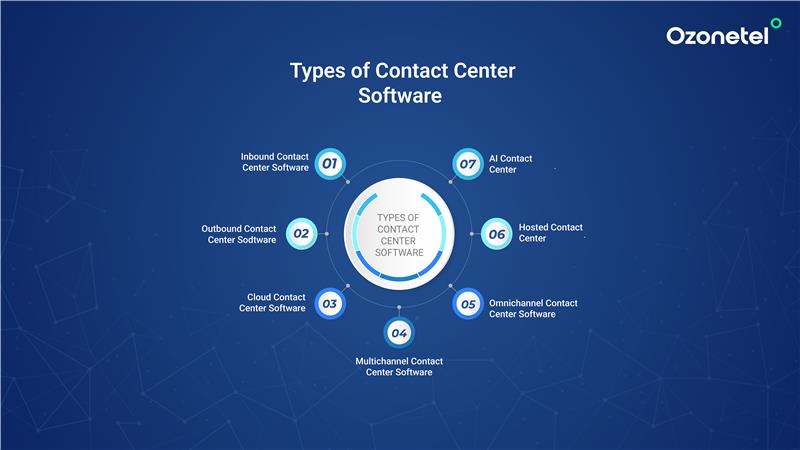
As you navigate the various options available, you must understand the different types of contact center solutions and how they align with your specific requirements. Here are the key types of contact center software you should consider:
Inbound Contact Center Software
Designed for managing incoming customer queries—calls, emails, or chats—inbound solutions focus on quick response and efficient resolution.
With tools like Interactive Voice Response (IVR), Automatic Call Distribution (ACD), and intelligent routing, customers are directed to the right agent without unnecessary delays.
Best suited for support teams, helpdesks, and order management, where timely, issue-specific responses are essential.
Outbound Contact Center Software
Outbound contact center systems are built for proactive engagement, like sales outreach, follow-ups, surveys, or debt collection. These solutions typically include features like auto-dialers, predictive dialing, and campaign management to help agents reach more people in less time.
Perfect for lead generation, feedback collection, and upselling, where efficiency and compliance are equally important.
Cloud Contact Center Software
Cloud-based contact centers operate entirely online, giving agents access from anywhere with an internet connection. This model supports remote work, global teams, and scalable infrastructure, making it ideal for fast-growing or distributed organizations.
Cloud solutions typically offer lower upfront costs, faster implementation, and better flexibility than on-premise setups.
Multichannel Contact Center Software
Multichannel systems allow you to engage with customers over various channels—voice, chat, email, SMS, or social media—but treat each channel separately. Agents are assigned to one channel at a time, often requiring customers to stay within a single mode of communication per issue.
Great for teams that want to offer more options without fully integrating every interaction into one thread.
Omnichannel Contact Center Software
Omnichannel platforms go a step further by unifying all communication channels into a single, integrated view. Agents can track customer interactions across calls, emails, chats, and more, ensuring context is never lost, even when the customer switches channels.
Ideal for companies focused on delivering seamless, consistent experiences, especially in customer-centric industries like e-commerce, travel, or finance.
Hosted Contact Center Software
Hosted solutions are managed by a third-party vendor but may require on-premise hardware or integration with internal systems. This is a middle-ground option—offering vendor support and scalability, but with more customization and control than pure cloud models.
Best for organizations needing custom deployments with external management support.
AI Contact Center Software
AI-powered solutions use technologies like machine learning, natural language processing, and predictive analytics to automate, optimize, and personalize customer interactions. Features may include voicebots, chatbots, sentiment analysis, agent coaching, and predictive routing.
Perfect for companies aiming to increase efficiency, reduce agent workload, and deliver smarter, more personalized customer service at scale.
What Features Modern Contact Center Provide
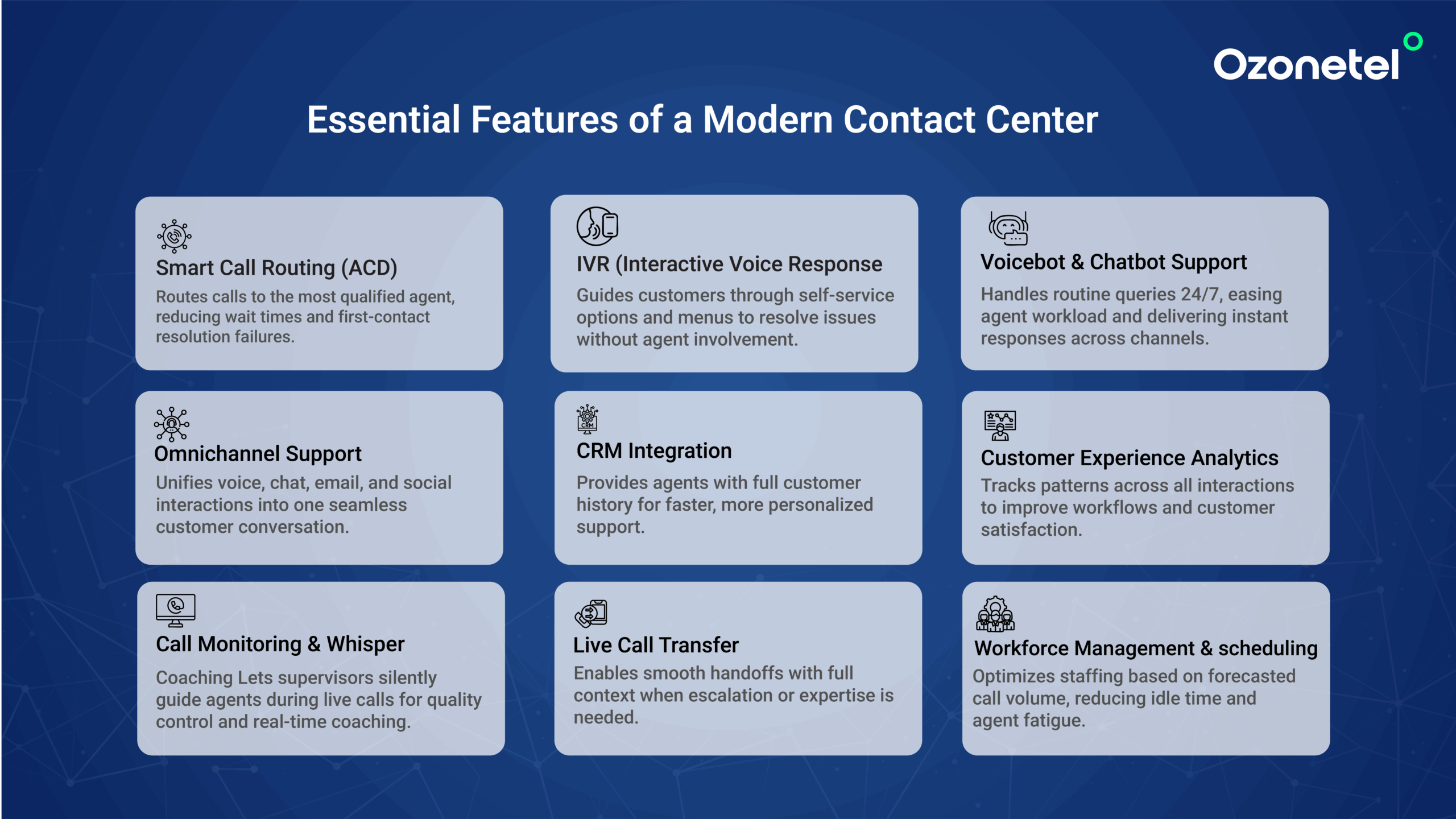
Your contact center is the front line of customer experience. The right features can drive faster resolutions, happier customers, and more productive teams. Here’s what a modern, efficient contact center should include:
Smart Call Routing (ACD)
Advanced Automatic Call Distribution routes incoming calls based on predefined rules—like agent skill, language, or workload. Instead of sending everyone to the next available agent, it sends them to the right agent. This reduces wait times, unnecessary transfers, and helps resolve issues on the first try.
IVR (Interactive Voice Response)
IVR systems act as the first line of interaction, guiding callers through a structured menu to direct them to the correct department. It also allows self-service for common requests—like tracking orders or updating account info—without needing an agent.
This significantly reduces call handle time and improve first-contact resolution rates by ensuring callers reach the right resource from the outset.
Voicebot & Chatbot Support
AI-powered voicebots and chatbots can handle repetitive queries around the clock—like billing questions, password resets, or appointment confirmations. They reduce queue times and agent workload while offering fast, consistent responses to customers across channels.
Omnichannel Support
Customers don’t just call anymore—they message, email, and comment. With omnichannel support, agents manage all interactions from one platform, regardless of where the conversation started. This ensures continuity, avoids repeated questions, and creates a seamless experience across touchpoints.
CRM Integration
When your contact center connects with your CRM, agents instantly see each customer’s full history: past purchases, tickets, and notes. This context helps agents deliver faster, more relevant support and makes customers feel known and valued.
Customer Experience Analytics
Customer experience analytics give you a clear picture of how customers interact with your brand—across calls, chats, and emails. Spot recurring issues, track agent performance, and use insights to streamline workflows and improve customer satisfaction.
Call Monitoring & Whisper Coaching
Supervisors can monitor live calls and coach agents in real-time without interrupting the conversation. It’s ideal for quality assurance, onboarding new hires, and reinforcing best practices—helping teams stay sharp and consistent.
Live Call Transfer
If an agent can’t resolve an issue, they can instantly transfer the call to a more suitable teammate—without forcing the customer to hang up and call again. All the context travels with the call, ensuring smooth handoffs and fewer frustrations.
Workforce Management & Scheduling
Effective scheduling tools help forecast call volume, align staffing accordingly, and assign the right agents at the right time. This improves SLAs, reduces idle time, and keeps agents from getting overwhelmed—resulting in better customer and employee satisfaction.
How does AI in the Contact Center Help?
AI is redefining how contact centers operate by shifting them from reactive service hubs to proactive, intelligent support systems. By automating repetitive tasks, analyzing customer behavior, and delivering real-time guidance, AI enhances both customer and agent experiences.
Here’s how:
Intelligent Call Routing
AI goes beyond traditional call routing by using real-time data and past interactions to assign the right agent to the right query. It considers customer history, issue type, agent performance, and even sentiment to make smarter routing decisions.
For example, a returning customer with a technical issue can be automatically routed to the same specialized agent they interacted with before—creating continuity, faster resolution, and higher satisfaction.
Voice Bot & Chatbot Automation
AI-powered voicebots and chatbots handle high-volume, routine queries across channels like chat, voice, and messaging apps. From tracking orders to resetting passwords, bots deliver instant, accurate answers—24/7.
This not only reduces wait times but also deflects simple queries from agents, allowing human support to focus on complex cases. As natural language processing (NLP) improves, bots are becoming increasingly capable of understanding nuanced customer needs and resolving more advanced issues.
Automated Self-Service & Call Deflection
AI enables sophisticated self-service experiences. Customers can check account balances, update personal details, or reschedule appointments without human assistance. This reduces call volume and boosts efficiency.
The result? Lower operational costs, faster service for customers, and reduced burnout for agents who are no longer tied up with repetitive tasks.
Deeper Customer Understanding
AI analyzes patterns across thousands of interactions to identify emerging issues, shifting preferences, and behavior trends. If there’s a spike in complaints about a product feature, AI can detect it early, allowing you to respond with targeted education, fixes, or proactive outreach.
It also builds dynamic customer profiles with context like purchase history, intent signals, and sentiment—giving agents the tools to personalize conversations in real time.
Real-Time Analytics & Personalization
Beyond behavior analysis, AI delivers actionable insights into agent performance, customer sentiment, and process bottlenecks. For instance, if feedback consistently indicates poor resolution on billing queries, you can retrain agents or revise workflows. You can also use these insights to deliver hyper-personalized offers to retain at-risk customers or upsell to loyal ones.
Agent Coaching & Support
AI continuously listens, analyzes, and provides instant coaching cues to agents during calls. If an agent misses a key empathy cue or talks too much, AI can flag it and suggest adjustments in real time. This live guidance boosts agent confidence, improves soft skills, and ensures more consistent service delivery.
Use Cases of Contact Center Software
Contact center software has moved beyond just handling calls. Businesses are using it to cut costs, automate workflows, improve agent productivity, and deliver better customer experiences—at scale. Here’s how different industries are using it effectively.
Stockbroking: Managing Volatile Call Volumes
AngelOne, a major stockbroking firm, relied on cloud-based contact center software to maintain stability during trading spikes. With call concurrency reaching 1,300+, the system never crashed.
They automated 40% of incoming queries through self-service IVRs, reducing pressure on agents. Call monitoring tools gave supervisors real-time visibility, helping them manage remote teams efficiently.
Ecommerce: Faster Resolution, Higher CSAT
Wakefit, an online home and furniture brand, adopted contact center software to keep up with growing customer expectations. They reduced their average handle time by 30%, resolved queries faster, and maintained a 95%+ call pick-up rate during peak hours.
Real-time dashboards helped track performance and optimize support during high-demand periods.
NBFC: Smarter Operations, Better Productivity
HDB Financials, a leading non-banking financial company used contact center software to automate routine inbound queries like account statements and EMI details.
With multilingual IVRs and auto-dialers, they scaled outbound campaigns and improved lead conversion. Manual tasks like call disposition were reduced by over 70%, freeing up agents to focus on more value-driven calls.
Conclusion: Why Ozonetel is a Smart Choice for Contact Center Transformation
At the heart of every contact center are people—customers who expect to be understood and teams who want the tools to serve them well. Ozonetel’s platform was built with this in mind, combining the reliability leaders need with the intelligence today’s customer experience demands.
That’s where Ozonetel stands apart.
- AI-powered sentiment analysis → Understand customer emotions in real time and act before issues escalate.
- Smart call routing → Direct customers to the right agent the first time, improving FCR and reducing wait times.
- Multilingual IVR → Deliver seamless self-service and support across diverse languages and regions.
- Real-time analytics → Give managers clear visibility into performance and customer journeys, enabling data-driven decisions.
- Deep CRM integrations → Equip agents with full context to personalize interactions and resolve issues faster.
- Intelligent dialers → Automate outbound calling, boost agent productivity, and scale campaigns without increasing workloads.
What makes Ozonetel stand apart is not only these capabilities but the way they come together in a single, cloud-native platform. For CXOs and contact center heads, it means greater agility, faster outcomes, and a trusted partner who ensures that transformation happens smoothly and at scale.
Ready to reimagine your contact center? Let’s build it together.
Prashanth Kancherla
Chief Operating Officer, Ozonetel Communications
Over the past decade, Prashanth has worked with 3000+ customer experience and contact center leaders...
Chief Operating Officer, Ozonetel Communications
Over the past decade, Prashanth has worked with 3000+ customer experience and contact center leaders to comprehensively understand the need for effective and efficient customer communications at every step of their journey with a brand. Deeply embedded in today’s CCaaS ecosystem, he has been instrumental in Ozonetel's growth and contributed in various roles including product management, sales, and solution architecture.
Frequently Asked Questions
A contact center is a centralized hub where businesses manage all customer interactions across various channels—phone, email, chat, social media, and more. Its goal is to resolve customer queries, provide support, and ensure a smooth customer experience.
AI contact center software uses artificial intelligence to automate and enhance customer support. It includes features like voicebots, chatbots, intelligent call routing, real-time analytics, and agent coaching tools—making interactions faster, more personalized, and efficient.
The core purpose of a contact center is to deliver timely, accurate, and helpful support to customers. It acts as the front line of communication, aiming to solve issues, answer questions, and build long-term customer relationships.
CRM (Customer Relationship Management) software stores and manages customer data, sales history, and interactions. Contact center software, on the other hand, facilitates real-time communication with customers. While CRMs help with context and records, contact center tools handle the actual engagement—often integrating with the CRM for a complete view.



